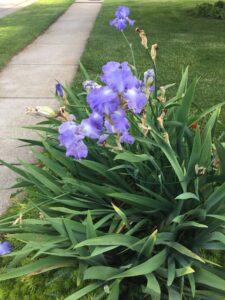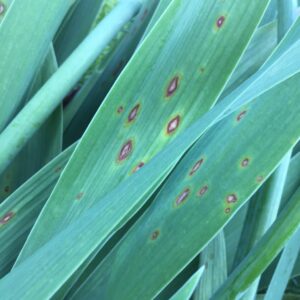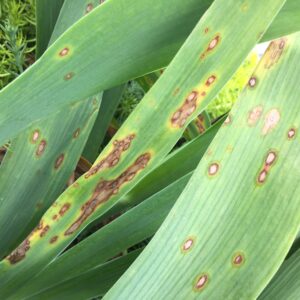Rhizomatous bearded iris (Iris x germanica) is a favorite early spring perennial; however, it is routinely troubled by a fungal leaf spot that tends to appear soon after flowering (Figure 1). These start as small wet-looking lesions that may quickly enlarge into larger spots with brownish edges, tan centers and yellow margins (Figure 2). When infection rates are high due to crowding or wet weather, the spots may coalesce and blight leaf tips or large sections of leaves (Figure 3). Repeated attacks may weaken rhizomes but this disease will not kill plants. The main effect is making plants look ugly after flowering is over.
- Figure 1: Iris leaf spot usually appears on susceptible bearded iris at the time of flowering.
- Figure 2: Iris leaf spot lesions tend to be elliptical with tan centers and a yellow halo.
- Figure 3: When conditions are right iris leaf spot lesions may coalesce, blighting the entire leaf.
The fungus causing iris leaf spot is Cladosporium iridis and spreads from diseased to healthy leaves during the summer primarily via splashing water. For this reason, infected leaf tissue should be removed as soon as it is observed. In addition, it is important to avoid overhead watering of foliage, to work with plants only in dry weather, to space plants in order to promote good air circulation and to use more resistant species. Since the fungus over-winters on plant debris, it is especially important to remove infected leaf and flower stalks in the fall.
Bearded iris species are more susceptible compared to the non-bearded varieties. Siberian iris (I. sibirica), crested iris (I. cristata) and I. graminea species appear to be tolerant or resistant to this disease, so these are candidates to replace highly susceptible rhizomatous iris.
Fungicides are generally not needed for this disease in the home landscape, but may be needed where other management techniques are not working, or when keeping a favorite bearded iris variety looking pristine is a priority. Pageant, Orkestra, Heritage and Iprodione products can be used as preventive sprays but getting fungicides to stick on iris can be a challenge.


